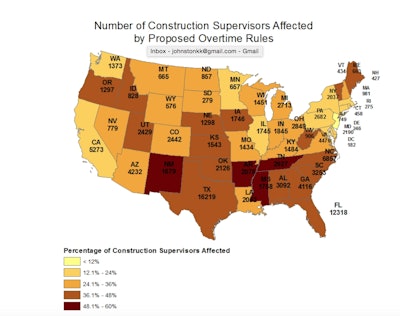
Under the proposed regulations that would change the Department of Labor’s (DOL) overtime pay rules the salary level required for the employee assistance program (EAP) or white collar exemption for overtime pay would increase from its current $455 per week ($23,660 per year) threshold to $970 per week ($50,440 per year) beginning in 2016. It is not surprising that the total count of construction supervisors affected varies with state size. However, as a percent of workers in that state, it is clear that lower cost-of-living states, namely in the South, are particularly affected.
This represents a 113% increase. Employers are required to pay overtime (time-and-a-half) to salaried white collar workers who earn less than these amounts and work more than 40 hours in a workweek. In addition, overtime-exempt workers must also perform “primarily executive, administrative professional duties.”
The state with the largest number of supervisors affected is Texas, followed by Florida, North Carolina and California. However, on a percentage of employment basis, the states with the largest scope of impacts are Arkansas, Mississippi, New Mexico and Tennessee, all of which have approximately 50% or more of supervisors currently employed being affected.
This geographic distribution is due to the fact that the DOL proposal uses a nationwide 40th percentile threshold, but wage amounts vary state to state.
(more on how the proposed overtime changes will affect the construction industry...)



















